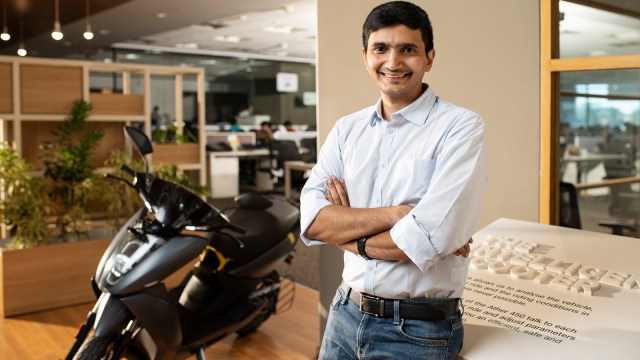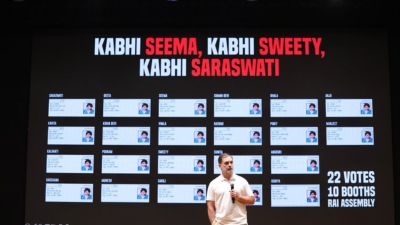India’s e-scooter market has grown nearly 29 per cent year-on-year since FY19. Ather Energy, in which Hero MotoCorp owns a 38 per cent stake, is the third-largest player after Ola Electric and TVS Motor with almost 12 per cent market share, according to an industry report by JMK Research. In a conversation with Aggam Walia, Swapnil Jain, co-founder and CTO of Ather, discussed the tapering down of electric vehicle (EV) subsidies, importance of “inorganic growth”, ways to boost charging infrastructure, and Ather’s supply chain strategy.

Incentivising auto components definitely helps the industry because the auto component players also have to do a fair amount of investments for the EV industry to grow and with them getting the incentives indirectly helps us as well. They would be able to spend more because there are uncertainties in any new industry and you need some sort of incentivisation for the industry to jump in.
Story continues below this ad
Evidently, the FAME scheme is tapering down. How do you see this development?
Any sort of a support system has to taper and industry has to take control on its own. Tapering is definitely something we were expecting as well. But having some amount of subsidy is important, not necessarily from a monetary perspective, but also from the message it gives that EVs are important for the government. It helps in general keeping some sort of a motivation in the industry that the sector is critical.
How many more years of FAME would be needed to make the EV industry more self-sustaining?
It’s not about self-sustainability. I would add that the more important thing is that you have to grow the industry. I would say at least two to three years (of FAME) is required for the industry to continue to keep growing. The subsidies have to be there from that perspective … Basically, you’re trying to put the industry on steroids. You want them to grow faster than how the natural growth would happen to be able to meet your carbon emission targets. At least two to three years is important so that the entire ecosystem can grow to a certain level, post which probably organic growth might suffice, but right now you need some amount of inorganic growth.
Story continues below this ad
Some of your competitors are looking at entering the full EV supply chain, be it cell manufacturing or mining of critical minerals. Is that a strategy Ather is considering as well?
We’re big fans of having the right focus and capital efficiency as an organisation– we don’t want to be doing multiple things. What we are good at is understanding cell design, chemistries, and the supply chain. However, we’d rather have someone else handle the cell manufacturing for us. This approach gives us advantages of scale and better risk mitigation compared to building our own cells. The bigger advantages come from controlling the cell design. We want to focus on partnering with existing cell manufacturers and potentially new ones within the country who can design to our requirements rather than us setting up cell manufacturing.
Recently, there have been some concerns around low utilisation of charging stations. Is that a trend you have noticed too?
We see a fair amount of utilisation of our Ather grids also because we have placed them in locations which are very accessible for customers. You don’t have to go off your route to get the vehicle charged. The expectation is to ease out on range anxiety and not necessary for daily usage. You are not expecting the usage to be 80-90 per cent because it is meant for a rainy day. But having said that, we have still seen a fair amount of utilisation.
Story continues below this ad
The big advantage that we have is that it is not too expensive for us to install a charging station and hence it’s okay for us. But again, coming back to the same point, do you want the industry to grow organically or inorganically? If you want the industry to inorganically grow, like what’s happening in China, then you need two things. One is that you need standardisation – all two-wheeler players using the same charging network will definitely improve the utilisation. Second, some sort of subsidy to set up charging infra will also really help because, again, it will give us the ability to do inorganic growth until you have enough critical mass.
Do you think mandating a charging standard is the way to go or should the industry generate some consensus on its own?
I’m not a big fan of mandating requirements. Mandates become unnecessary trouble for everyone, irrespective of benefits. The industry has to mature by itself and understand the need for a common charging standard. We’ve open-sourced the Ather charging standard, made designs publicly available, and worked with BIS to make it an India charging standard. We’re trying to create a consortium where OEMs, charge point operators, and tier one guys can come together. We have no interest in keeping these standards proprietary. In the US, the Tesla standard was superior, so people moved to it despite CCS being more widespread. We believe the same will happen here – the superiority of the technology will prevail. At some point, the industry will have to come to peace with agreeing on a charging standard.
In terms of evolving consumer expectations around product features and connectivity, what will an e-scooter of the future look like?
Story continues below this ad
I think Indian two-wheeler customers have been deprived of good features for a long time. Before 2017, there wasn’t much innovation. Indian consumers are cost-conscious but definitely desire value. Since Ather launched its 450, people’s expectations have changed significantly. Now everyone’s coming up with touchscreens and connectivity. Consumers have learned they can demand more, like in four-wheelers where people are moving from small cars to SUVs. The scooter segment is changing from utilitarian to something people can show off. They want car-like features in two-wheelers. We’ve been pushing the industry to give features not thought of before. Companies providing differentiated experiences will win the market. We’re leveraging connectivity with features like WhatsApp and Alexa integration, Google Maps navigation. We’re changing how people interact with vehicles– touch, voice, mobile app. You get notifications from the vehicle too. With EV powertrains, we get more control. We launched skid control, which is a big deal for ICE vehicles. You’ll see more premium features like speed control and emergency brakes coming to mass-market e-scooters.

































